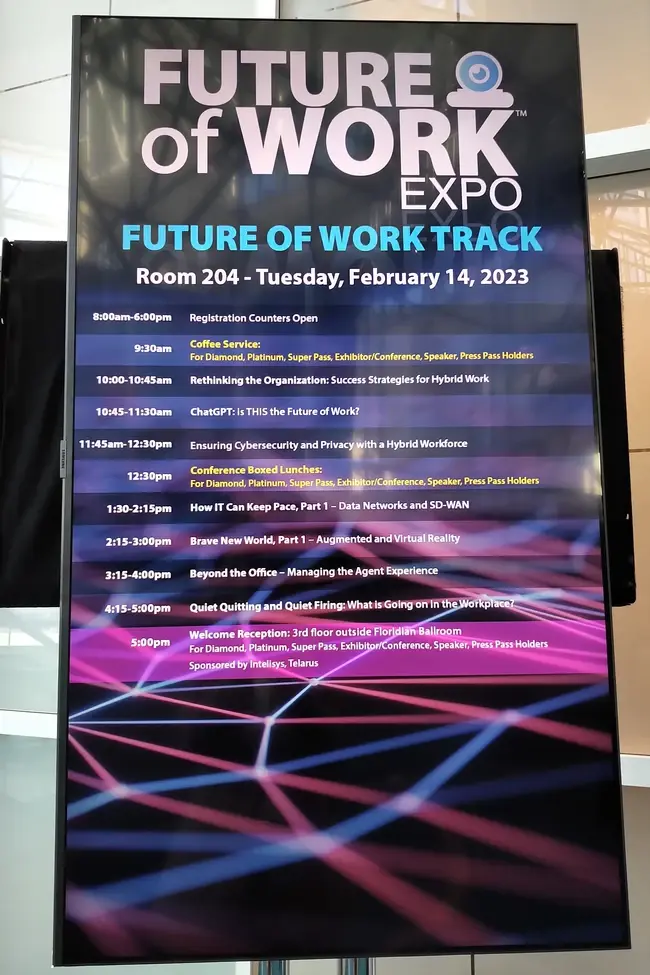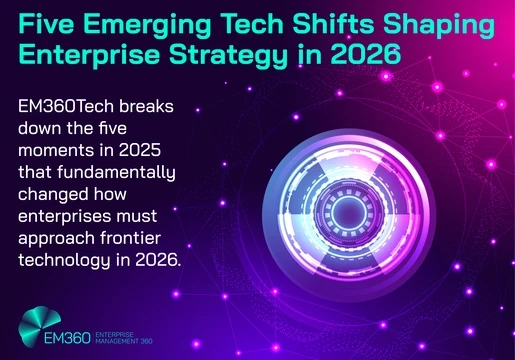As an independent analyst, I get to wear many hats, and last week, I returned to my conference Chair role for the Future of Work Expo in Fort Lauderdale, Florida. This is my fifth year in that role, and as the program evolves over time, I can say that the event is now finding its voice. Over the years, I’ve played all the behind-the-scenes roles that go into building and running a conference, and audience reaction is always the best barometer for all the hard work finally paying off.

That was very much the vibe at FOW Expo, and I’m already thinking ahead to the 2024 edition. Most EM360 readers won’t be familiar with my event, and for background, it’s part of the long-running IT Expo, which is now in its fourth decade. They’ve certainly found their voice, and under their tent, FOW Expo already has a built-in audience. Since the sessions were not recorded, you had to be there to take it all in, and to give you a sense of what we covered, here are five themes that reflect how we see the future of work evolving.
Theme 1 – Hybrid work is hard to get right
This may seem like an understatement, especially since there’s no precedent for doing this at scale. While sectors like hospitality or healthcare are facilities-based by nature, all types of businesses are looking for ways to support a mix of onsite and offsite modes of work. Much of our focus is on office-based settings where knowledge workers are the norm, and despite having been pressed into hybrid work during the pandemic, most businesses still struggle to make it work.
I cited a current study from AMA’s Hybrid Index Report showing that 41% do not have a plan in place for hybrid work. This study also validated that the best days for having employees in-office are Tuesday, Wednesday and Thursday, with Monday and Friday being the best days for home-based working. There’s no hard and fast rule about this, but for business leaders looking to develop a hybrid work plan, this study is a pretty good benchmark.
On another panel, colleague Chris Fine shared highlights from the Powering Hybrid Work 2023 study, jointly produced by Aruba HPE and Leesman. This study supports the broad premise that hybrid work is not easy to do, but also emphasized the need for a human-centric approach, where the work setting is optimized for the type of work that needs to be done.
Some forms of work are more task-oriented, whereas others are team-based, and this really should dictate the work setting along with the tools needed to be productive. The latter point underscores the importance of providing the right technologies, a topic that was further explored on several other sessions.
Theme 2 – ChatGPT is hot
This topic was not on the radar when planning out the program, but being the trend du jour, we just had to address it. In general, ChatGPT is hard to ignore, and it’s a great example of how quickly new technologies and applications can go mainstream in today’s digital world. The novelty factor is undeniable, but there’s already been strong pushback since the potential for mis-use is so broad.
We covered all this ground and more during our session, with a main message being to know what ChatGPT is and is not. Being AI-based, ChatGPT – and its ilk, such as Bard and Jasper – can draw from the entire universe of digital content, both for text and visual images. This is far beyond what humans can do, making this a very efficient information-gathering tool, and in some ways, a better search experience.
However, like other AI-based applications, it has its share of biases, and can only project from existing forms of knowledge. For the time being, it can be a very helpful research tool, as well as being a great source of inspiration if you need a starting point for writing or a presentation. Just don’t count on it to do all the thinking for you, unless you’re not fussy about the final product. As a writer, my concern is more about plagiarizing my work, but as the bots take over, I’m afraid that might be a losing battle.
Theme 3 – IT’s job isn’t getting any easier
Things have never been easy for IT, but supporting a mix of onsite and offsite workers takes things to another level, and for that reason, we had two IT-related panel sessions. One was about the role of SD WAN for network infrastructure, and another was about the challenges around supporting the ever-increasing range of endpoints.
As workforces become more mobile and more decentralized, conventional networks need to adapt, and our panelists talked both about the underlying technologies, as well as how IT needs to think about what’s needed in this new model. Workers need out of the box experiences that can be provisioned easily and managed securely.
With endpoints evolving so quickly, another area of discussion was DaaS – device as a service – which is gaining traction as a way to ensure that endpoints can properly support today’s workplace applications, as well as platforms like UCaaS.
Theme 4 – Contact center evolution is challenging
Yes, agents are workers too, so FOW very much includes them, and we had three sessions exploring various contact center-related themes. Just as knowledge workers are becoming UCaaS-based, CCaaS is playing a similar role to make agents both more effective at driving CX, as well as happy in their work. The twist here is extending those capabilities to all agents, especially those at home, who don’t have the benefit of supervisors looking over their shoulder, or other agents nearby to confer with.
A -picture topic was the notion that contact centers have been radically transformed during the pandemic, and how successful adaptations could serve as a template for other operations inside a business to learn from. Change is never easy, but contact center leaders had no choice, as customer needs must continue to be served, and if anything, they’ve become more challenging.
Contact center transformation remains a work in progress, and we had a healthy discussion about what forms that will take. That aside, we also talked about how CCaaS is evolving to keep pace, especially on the AI front to help agents drive better CX, as well as automating service to handle higher volumes of traffic.
Theme 5 - Virtual workspaces are coming
Titled Brave New World, we had two sessions on this theme, with one being about AR/VR – augmented and virtual reality, and that broad spectrum where virtual experiences are becoming more immersive. Separate, but closely related, we also explored the metaverse, which represents the environment where these virtual experiences can be held.
We did have difficulty keeping those topics separate, but nobody seemed to mind, as these are all new frontiers that will invariably be connected once they gain traction. A clear takeaway from these sessions was that use cases in the workplace are still limited, so there’s really not much FOMO for IT leaders to lose sleep over – for now.
That said, we certainly had consensus that it’s just a matter of time, especially as digital natives come to dominate the workforce. More practically, though, we also talked about how the current state of technology is simply not there yet, especially for the cost of headsets, the bulky form factor, and limitations around bandwidth and PC processing power. In time, we agree these will be overcome, and my advice for now is to carefully follow what gamers are doing, as they are the early adopters of all these technologies.







Comments ( 0 )